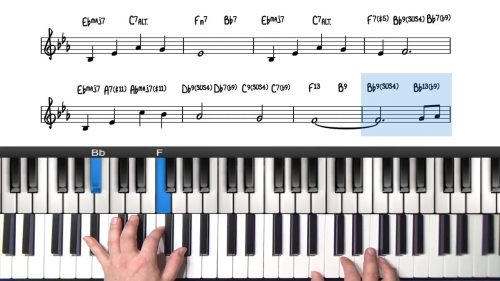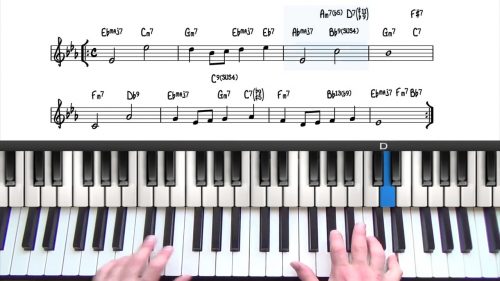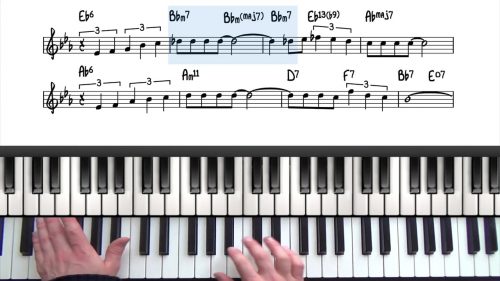The Most Beautiful Chord Progression
In this lesson we explore the beautiful 1436251 Progression in the key of Eb Major. If you are looking for a nice chord progression to introduce your jazz standards, this is the progression you have been waiting for.
Diatonic 7th Chords
We start by building the diatonic 7th chords in the key of Eb to understand the base chords that we are working with. We then start to change the chord qualities to dominant 7 which allows us to access more interesting colours and textures.
Introductions To Jazz Standards
This progression is the perfect introduction for any tune that starts on the Imaj7 chord. A nice touch is to run up the upper structure triad on the final V7 chord which then leads smoothly and convincingly into the start of the tune. We demonstrate using this intro for the tunes “Misty” and “Over The Rainbow”.
Lesson Downloads
-
1436251 Progressions Worksheet File Type: pdf
Practice Tips
-
Learn the progression in Eb Major - the same key that we use in this tutorial.
-
Apply this progression as an introduction to all of the tunes that you know in the key of Eb.
-
Download the PDF supplement and learn the progression in a new key or 2.
-
Apply this to other jazz standards in that key.









Beautiful indeed! :)
Handy intro progression. Still working on getting my head out of thinking of the piano notes and switching to the degrees intervals. What’s the best drill to help memorize degrees.? I’m doing Jazz foundation simplified practice planner.
Best
Eric
Hi Eric,
If you check out the first lesson in this course, we explore the 251 and the 36251 progression in the key of Eb Major: pianogroove.com/jazz-piano-lessons/eb-major-diatonic-harmony/
The only different between the 3-6-2-5-1 progression and the progression in this video, is that here we start on the 1 chord, and then go to the 4 chord (Ab7) which creates a half step dominant resolution into the 3 chord which starts the 36251 progression.
In the simplified foundations planner that you reference, there is a drill for the diatonic 7th chords (Drill 5 in the practice plan): pianogroove.com/jazz-piano-lessons/essentials-practice-guide-simplified/
The diatonic 7th chords are the basis for numeric analysis, and so learning these is important, and of course we can also learn and memorise the 251 and 36251 progressions in all 12 keys, perhaps just starting with 2 or 3 keys as directed in the essentials practice planner. You can quizz yourself away from the piano and ask yourself “what are the 36251 in XYZ Key”, and if you can’t find the answer you need to learn the numerics and diatonic 7th chords when back at the piano.
Remember that these numbers relate to the scale degrees, and so simply learning the major scales numerically will also help you with this kind of analysis. Learning scales numerically is really the base for all of this stuff.
Finally, you can write the numerics on your lead sheets above the chords. For example this song “Misty” starts with the 1 chord (Ebmaj7) then we have a 251 to the IV chord of the key (Bb-7 to Eb7 to Abmaj7), and on the second line of A section of Misty we have 2 x 3625 progressions (G-7 / C7 / F-7 / Bb7). Many jazz standards follow this format. Learning lots of new songs will help you to identify these patterns.
I hope that helps!
Talk soon,
Hayden
PS, after downloading piano grooves materials is there a way to electronically markup a chart so I don’t have to always print paper? Perhaps iPad with pencil? I’m a Mac user
Hi Eric,
This is possible on my MacBook. I can click the “pen” icon on any PDF file and then i can type on top of it and draw on it electronically.
Personally, I prefer hand notating the lead sheets in a fine pencil, but I’m sure it’s possible to do this electronically on your iPad to avoid printing paper.
I see here is a guide on the Apple website: support.apple.com/en-by/guide/ipad/ipad6c8f7f84/ipados
I hope that helps.
Cheers,
Hayden
Hi Hayden,
Do you have a course or recommendation for an intro progression for songs beginning in minor keys? I’m working on your arrangement of Body and Soul, beginning in Ebm7
Thanks
Hi John,
Please excuse my late reply. Your comment slipped off my radar.
Yes, we have a dedicated seminar where we create a beautiful intro progression for the song “Body and Soul”. You can find a link to that here: pianogroove.com/live-seminars/body-soul-jazz-standard/
The introduction that I break down is based on the Beegie Adair version of “Body and Soul” which is one of my favourite solo piano versions of the tune.
It’s important to understand that whilst the song starts on Eb-7 (the ii-7 chord in the key of Db Major) we still create our introduction progression in the key of Db Major, and I simply play the VI7 dominant chord at the end of the introduction which beautifully sets up the ii-7 chord to start the song.
Please check out the seminar above where which covers some interesting topics such as targeting alterations, and also using suspended chords to create harmonically rich introductions. I think this is exactly what you are looking for.
If you have any further questions on the techniques I use, you can post your questions on the seminar page, and I’ll be more than happy to assist.
Talk soon,
Hayden
Hi John,
I realised that I also taught another introduction to Body & Soul which you can find here:
pianogroove.com/live-seminars/solo-jazz-piano-secrets/
Please watch from the chapter “Using The Soft Pedal” which starts at 13m18s
This is also one of my favourite piano introductions from a player that I like on YouTube – his channel is “PianistaItaliano” and he has a lovely solo piano style.
This will give an alternate introduction to the Beegie Adair version that I referenced in my previous comment.
There are some similarities in both introductions – such as the suspended chord voicings – and so I think it will be useful for you to see how 2 different musicians approach the use of sus chords in their introductions.
Have fun playing around with this stuff!
Cheers,
Hayden